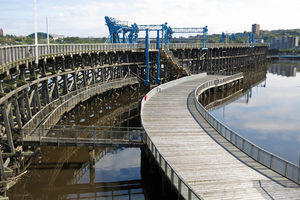Dunston Staiths in Gateshead, England

The term “staith” is used in northeastern England to describe a ship or boat loading structure. They are usually served by rail lines and contain loading chutes for bulk minerals.
Dunston staiths is a 19th-century coal loading structure on the River Tyne near Gateshead, England. From here, millions of tons of coal per year from the highly productive coalfields of the area were once loaded onto ships for export to other parts of the country and beyond.
The structure was constructed by the North Eastern Railway. The wood used for the staith was primarily pitch pine balks, imported from the United States. In recent years, repairs were necessary after the structure was damaged in several fires. Red ironwood was used during repairs, as pitch pine was no longer considered stable.
The staiths are more than 1,000 feet (526 meters) long with four railway tracks and six loading bays. The structure is said to be the largest timber structure in Europe.
Today, this magnificent feat of architecture stands as a tribute to the ambition of British engineers during the Victorian period. The staiths stopped working in 1977, however, it’s currently a listed structure under ownership of the local authority.





